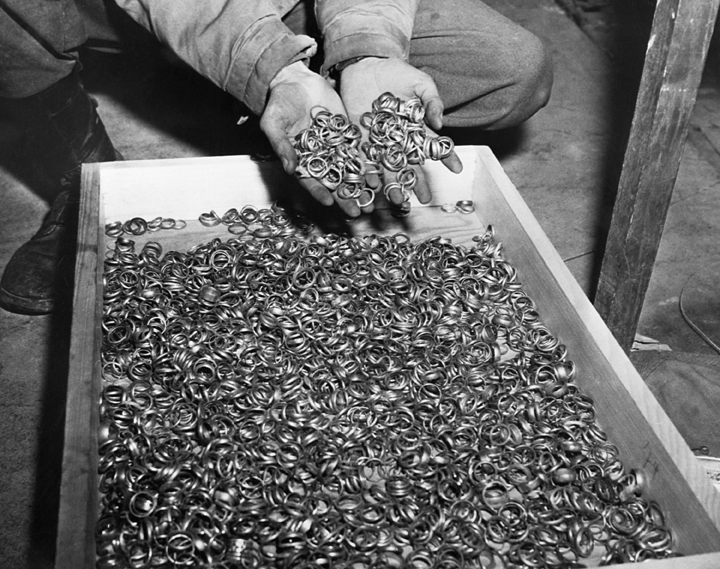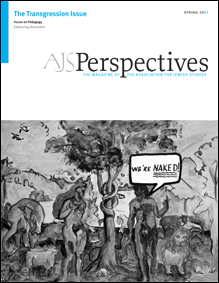
The views or opinions expressed in this article, and the context in which the image from the U.S. Holocaust Memorial Museum collection is used, do not necessarily reflect the views or policy of, nor imply approval or endorsement by the U.S. Holocaust Memorial Museum.
I begin by emphasizing the materiality of transgression in order to get closer to the kinds of refusal I hope to consider in relation to Holocaust studies. Scholars like the Israeli philosopher Adi Ophir have challenged the "sanctification" of the Holocaust, going so far as to write an "antitheological treatise" about the dangers of such forms of reverence. Early on, even Jacob Neusner warned against "the myth of Holocaust and Redemption." Still, there is no going back. Various forms of sanctification have already left their mark even as many of us have attempted to resist their allures. With this in mind, I want to consider a different layer of this legacy. I want to think more concretely about the residue that these discourses have left. I am interested in the perhaps less-than-conscious rituals that animate our engagements with Holocaust objects. Although I am compelled by critiques of theological versions of Holocaust sanctification, I want to risk deploying religious discourse otherwise in order to appreciate more fully the work of holding this past in the acts of caring for and preserving Holocaust objects.
When it comes to artifacts, this transgression takes a somewhat different form. It is more closely aligned with the kinds of discomfort around aesthetic objects and works of art and architecture that are, as Brett Kaplan has written, "unwanted." Here the prohibition is about containing the power of offensive objects. And yet, even these barriers do not stop the kinds of affective engagements such works nevertheless produce. Prohibitions cannot stop these engagements, they only seem to send them underground.
Entering the Holocaust archive and its holdings, I want to consider what it might mean to actually allow ourselves to use religious language to address the materials that embody this legacy. To make my case, I build on Oren Stier's notion of Holocaust "icons" and "relics" and religious studies scholar Jennifer Scheper Hughes's account of the agency of sacred "object-entities." With them, I argue that a more robust engagement with religious discourse, a discourse that has historically appreciated the animating character of objects as we interact with them, can enable us to address more fully the vibrancy of Holocaust artifacts and their hold on us.
In my larger project, I consider both those material artifacts housed in Holocaust museums such as the United States Holocaust Memorial Museum (USHMM) and those held in police storage facilities as evidence of specific violent crimes, especially rape and murder. What does it mean to hold once-ordinary pieces of clothing, bedding, a suitcase, or a toothbrush in custody? What do these strangely bristling objects have to tell us about the crimes they witnessed? What are our obligations to them in an ever-changing present?
The common rationale for why we hold such objects is that they can be deployed as evidence. They enable us to prosecute those responsible for such crimes in legal trials and tribunals and in the historical record. But most of what is held in Holocaust collections is not legal tender. The allure of these objects exceeds this kind of use value and cannot account for the tender regard that permeates their ongoing care.
What attracts us to the smell of decaying shoes in the permanent exhibit of the USHMM, the fragile materiality of those striped concentration camp uniforms, or the poet Maggie Nelson's account of a bloodied pair of pantyhose used to strangle Jane Mixer, a law student at the University of Michigan murdered in 1969 whose case was reopened over thirty years later after a one-in-a-million DNA match? In all of these instances material objects speak, they call out to us in ways not contained by the more overt narratives of criminal evidence. Such tainted objects beckon. And so it is that I have been wrestling with the question of how these otherwise lifeless objects move us, how they demand our tender regard.
Writing about Mexican devotional practices, Jennifer Hughes refuses the instrumental logic of objects as evidence. Insisting on the vibrant agency of religious artifacts, she propels me to dig deeper into why it is that I find myself so obsessed with once-ordinary possessions transformed by violence. With this in mind, I see such Holocaust objects as strangely sacred. In other words, as Stier shows us, in places like the USHMM, the language of a kind of Christian material and visual culture, icons and relics, helps flesh out a process of contemporary Jewish communal commemoration.
Even as these same efforts are resisted by so many of us in Jewish Studies as sacrosanct, this kind of religious language animates these affective engagements increasingly with objects. And these practices are everywhere apparent in efforts to preserve Holocaust memory in its materiality.
Stier was among the earliest scholars of Holocaust memory to move from textual study not only to monuments and memorials but to the enactment of memory through ritual and performance as well as museum exhibitions. In his most recent work Stier uses material, numerical, rhetorical, and both written and photographic "icons" to link picture theory with scholarly work on religious icons. By noticing how religious icons cross genre boundaries, he shows us how they make accessible that which remains otherwise just out of reach—the lessthan- articulate animating qualities of these objects and figures. What role does ritual play in the display of various sacred objects— religious and otherwise—at the USHMM? By offering an account of the complicated halakhic considerations that went into the museum's display of a desecrated Torah, for example, Stier points to the rituals that surround all of our engagements with the museum's rescued evidence.
Writing about the question of "evidence" in the study of North American religion, Jennifer Hughes writes about a kind of shared religion-affective posture of tender regard for mundane objects imbued with life. She insists that such objects are engaged as sacred persons. They are beings and not things. For Hughes, these object-entities are vital and dynamic. They are agents in these communities, "material manifestations of the sacred, to whom devotees and practitioners attribute animus—existence, being, desire, and potency. They possess a 'vital materiality.'" Following Hughes, I want to suggest that Holocaust objects are similarly animate.
Explaining some of the reasons why so many scholars bristle at these kinds of claims, nevertheless, I, like Hughes, want to insist that sacred objects are not passive vessels to be used for some other purpose like the terms fetish and animism presume. Such "object-entities" are not narrowly, and certainly not exclusively, "evidence"; rather, they are "active participants in the complex religion-social networks that ethnographers of religion observe and describe." Hughes continues "Objects performing as evidence do so through the 'prerogative of power.'" Given all of this, like Hughes, I am interested in deploying "vital materialist ontologies" in order to better attend to the bristling objects held in Holocaust museums and their power over us.
Let me say this differently: in order to better appreciate the vitality of presumably lifeless Holocaust objects, I suggest we stay with Hughes and Stier and more fully embrace the rites and rituals of those who hold them, the ongoing labors of conservation and custody as sacred practices. To do this, we have to acknowledge that the prohibition on religious discourse in Holocaust studies has already been breached. There is no turning back. To touch these powerful enactments and their ongoing importance, we need to work with the unconformable deposits of the sacred that already mark such collections and their care.

